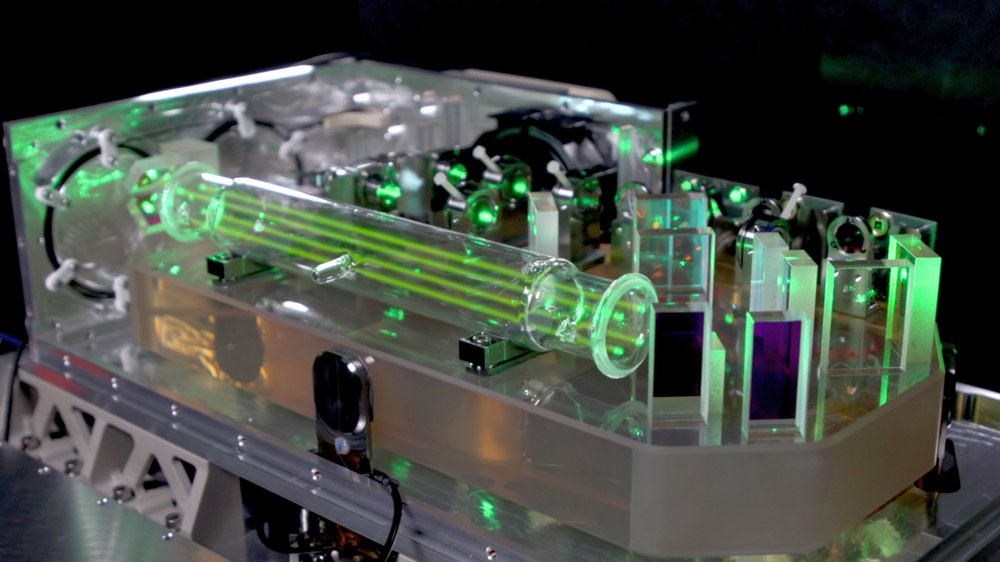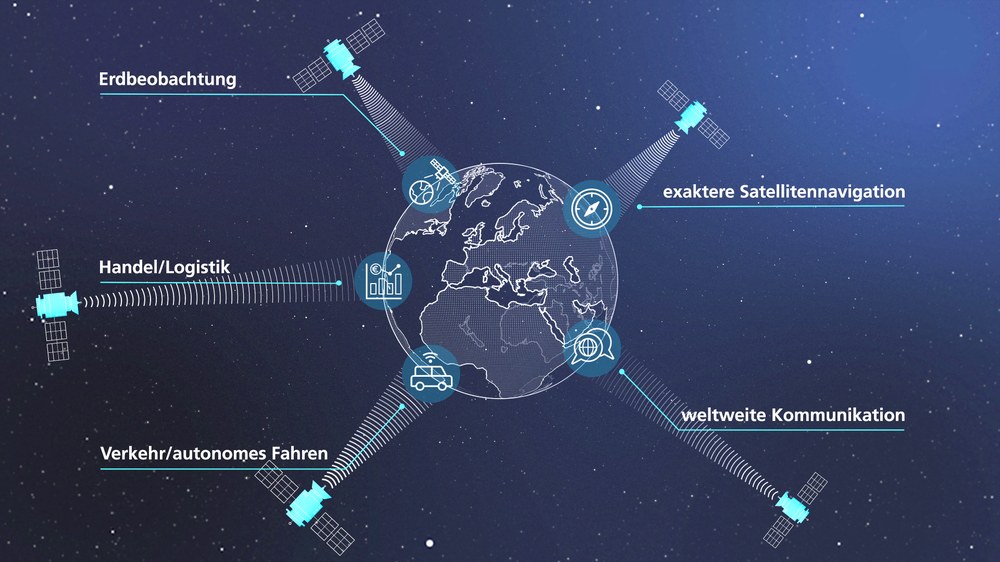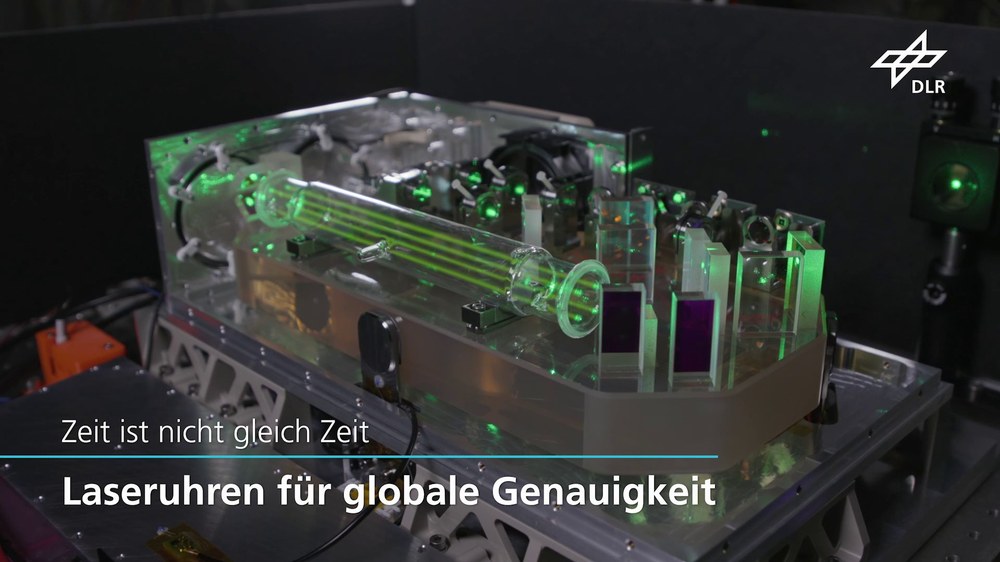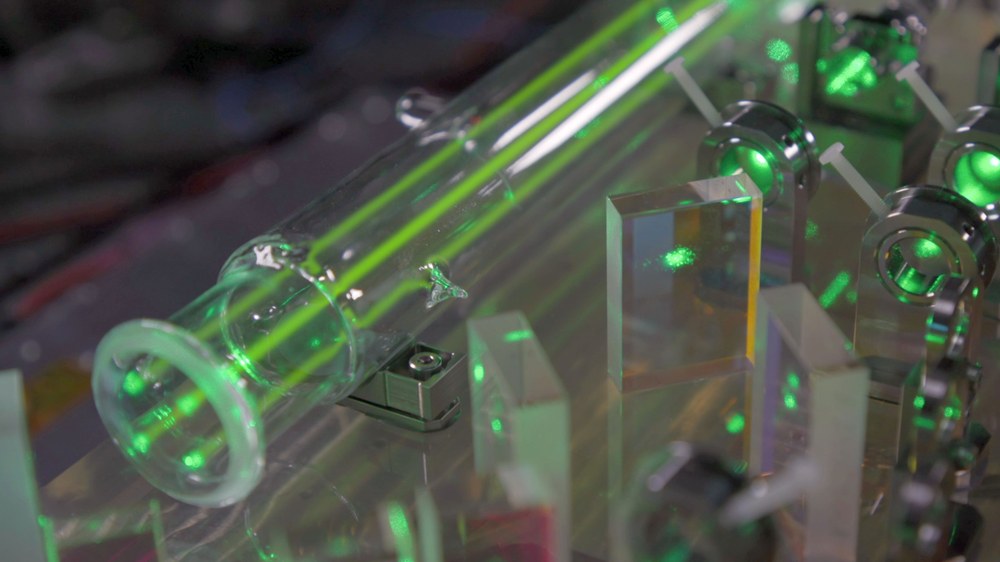DLR laser clock achieves world-class accuracy



- A laser clock developed by DLR has achieved a record level of accuracy for optical clocks, with a deviation of just one second every 30 million years.
- Laser clocks are set to improve satellite navigation and deliver a precise global time signal.
- From 2027, DLR will test a laser clock on the International Space Station ISS.
- Focus: Spaceflight, quantum technologies
A new laser clock from the German Aerospace Center (Deutsches Zentrum für Luft- und Raumfahrt; DLR) has achieved a record level of accuracy for optical clocks with gas cells: in 30 million years, it would be off by just one second. The quantum properties of iodine molecules determine the rhythm of this laser clock.
Space-grade laser clocks are set to contribute to positioning systems with centimetre accuracy and deliver a global time standard. They promise new possibilities for more powerful data transfer in areas as varied as global communications, network mobility, autonomous driving, trade and logistics.
DLR is currently developing and building a space-grade laser clock as part of the COMPASSO project. From 2027, it will be tested on the International Space Station ISS with the aim of using optical clocks on satellites.
Not all time is equal
When asked what time is, Albert Einstein once said: "Time is what we measure with a clock." This all depends on the accuracy of the clock. How well satellite navigation, the Internet, Earth observation applications or even the finance sector work depends on the accuracy of the time data required for data transmission. Satellite clocks provide time signals that can be used, for example, to determine positions on Earth or synchronise communication networks.
In the future, space-grade laser clocks will be able to provide time information more precisely than today, making satellite services even more efficient and precise for communication and navigation. Due to their higher frequency, laser-optical clocks are approximately 100 times more accurate than current microwave-based satellite clocks.
Laser clock achieves record precision
DLR has developed the high-precision laser clock in the COMPASSO project drawing on its leading expertise in quantum technologies for spaceflight. "It deviates from so-called Universal Time by less than 100 picoseconds per day. A picosecond is one millionth of a millionth of a second. This deviation corresponds to one second every 30 million years," explains Claus Braxmaier from the DLR Institute of Quantum Technologies in Ulm. "We are closing the gap between the accuracy of conventional satellite clocks and the large, heavy, high-end atomic clocks that currently determine our universal time in national metrology institutes."
The rhythm of the laser clock is set by quantum physics. To achieve it, the laser wavelength is tuned to match the frequency of iodine molecules in a gas cell. The rate of the oscillation is solely dependent on the quantum mechanical properties of the iodine, and the optical clock’s high level of accuracy can be achieved with this device-independent benchmark.
DLR researchers have further developed the laser clock to its current accuracy in the clock laboratory at the DLR Institute of Communications and Navigation where they have compared it with another precision clock, a so-called hydrogen maser – a type of laser in the microwave range. "By superimposing the clocks' time signals, we can count the individual pulses of the laser clock like a stopwatch. These follow each other at a frequency of ten megahertz, which is ten million beats per second," explains Braxmaier. "This allowed us to determine both the accuracy and the precision of our laser clock. The more precise a clock is, the more consistent its rate. The accuracy indicates how far it deviates from the target value after a certain time."
Laser clocks for global accuracy
The aim of the COMPASSO project is to develop key optical technologies for future satellite navigation. "Our vision is to use the high accuracy of laser clocks for globally available time information. This would make it possible to establish a globally uniform and precise standard time," says Braxmaier.
"New generations of highly precise, space-grade laser clocks will significantly improve the performance of satellite-based technologies," explains Stefan Schlüter from DLR's Galileo Competence Center. "Important areas include autonomous driving, telecommunications, disaster management and the financial sector." The accuracy and higher frequency of laser-optical clocks should also enable more powerful communication networks with higher data rates.

Video: Laser clocks for global accuracy
Your consent to the storage of data ('cookies') is required for the playback of this video on Quickchannel.com. You can view and change your current data storage settings at any time under privacy.
En route to the ISS
The DLR Institute of Quantum Technologies is currently developing a space-grade version of the laser clock, which is set to be launched to the International Space Station in 2027. If it is to be used in space, the clock must be particularly light, compact, robust and reliable. During actual operation, satellite clocks must be able to run autonomously and trouble-free for at least 15 years.
"We want to test a flight model of our laser clock on the European Bartolomeo platform on the ISS. In this external laboratory, the clock is exposed to space conditions. It must operate flawlessly in a vacuum, in direct sunlight and in Earth's shadow, in deep space without direct access," explains Braxmaier. "The challenge here is to keep the temperature of the iodine gas cell at 20 degrees Celsius – regardless of whether it is exposed to sunlight or in the shade. The constant temperature is crucial for the high accuracy of the clock. We want to show that our clock is suitable for the next generations of Europe's satellite navigation system, Galileo."
Currently, the components of the laser clock are still set up on a laboratory bench. Next, the research team must assemble the clock as compactly as possible, to ensure that everything fits within the dimensions of two shoe boxes. The laser system contains specially temperature-stable and age-resistant materials, such as Zerodur glass. A highly stable lightweight construction guarantees that the clock can withstand the vibrations and forces that occur during the rocket launch. Once in space, nothing can be allowed to warp to ensure that the wavelength of the laser remains constant, to achieve a precise time signal. "The components of the laser clock have already successfully passed several endurance tests, for example on sounding rockets and in the drop tower," says Thilo Schuldt from the DLR Institute of Quantum Technologies.
Mini laser clocks open up new applications
Using clock technology with gas cells that set the clock's rhythm has another advantage: it can be made even smaller. Laser clocks the size of a smartphone with this degree of accuracy open up completely new applications and economic prospects.
For example, vehicles equipped with mini laser clocks in road traffic or delivery drones in cities could be networked with common navigation management system, providing information about traffic flows that could increase efficiency and safety. "Combining onboard laser clocks with acceleration sensors would also make it easy to bridge poor or interrupted satellite reception. The high signal stability of the laser clock provides the basis for calculating exact position data even under difficult navigation conditions, for example between rows of houses or in tunnels," explains Schlüter.
How does a laser clock tick?
Just as the pendulum in a grandfather clock sets the rhythm, an 'iodine-stabilised laser' determines the rhythm for the COMPASSO clock. For this purpose, a laser beam passes through a gas cell approximately 20 centimetres long, containing iodine molecules that serve as a natural time reference. The wavelength of the green laser light is regulated to match the specific vibration of the atomic nuclei of iodine molecules. The frequency of this oscillation is determined by the quantum mechanical properties of iodine. This means that the time reference is device independent, resulting in the high accuracy of the laser clock.

To generate a standardised time signal, the green light of the iodine-stabilised laser is superimposed with the laser pulses of a so-called frequency comb laser. Its spectrum comprises up to a million colours. The corresponding light frequencies lie at exactly the same distance from each other, like the teeth of a comb and comparable to a ruler. Like tuning a musical instrument with a tuning fork, a standardised clock signal is generated by measuring the intensity of the two superimposed laser beams. This is in the range of radio frequencies at 10 megahertz.
Related articles
Downloads and link
About the COMPASSO project
In the COMPASSO project, DLR is testing and qualifying novel laser-optical technologies for use in space. The DLR Institute of Communications and Navigation in Oberpfaffenhofen and the DLR Institute of Quantum Technologies in Ulm are working with the space industry to develop powerful and resilient laser systems for satellite navigation and scientific missions. The COMPASSO project name is based on a calculating instrument used by the Italian scholar, astronomer and mathematician Galileo Galilei (1564-1642).
The DLR Institute of Quantum Technologies, the DLR Institute of Communications and Navigation, the DLR Institute of Optical Sensor Systems and the DLR Institute of Space Systems are involved in the development of the COMPASSO laser clock. DLR's Galileo Competence Center is leading the project in close cooperation with the DLR Institute of Software Technology and DLR Space Operations and Astronaut Training. Project participants from industry and research include Tesat-Spacecom, Menlo Systems, Airbus Defence and Space, SpaceTech Immenstaad, the Institute of Scientific Instruments at the Czech Academy of Sciences and the Ferdinand-Braun-Institute.
The DLR Galileo Competence Center
The goal of the Galileo Competence Center is to actively advance, help shape and expand the future of satellite navigation. Since 2019, it has been pooling the results of research activities from DLR's institutes in order to implement and demonstrate future-proof concepts and technologies for satellite navigation.
